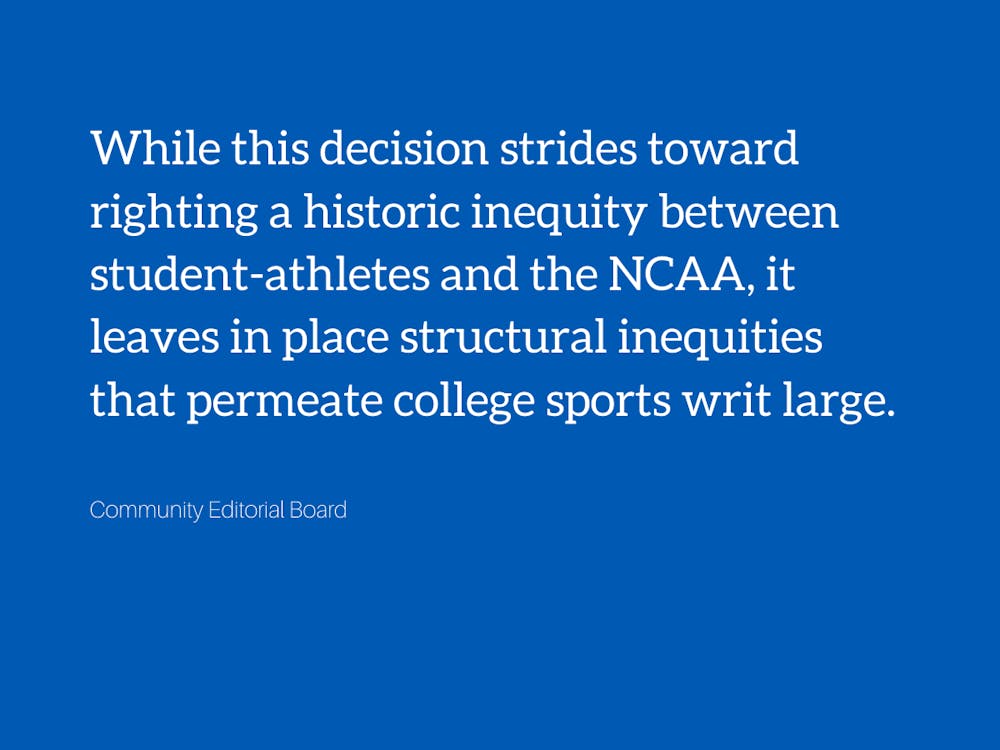The members of the Community Editorial Board are independent of the Editorial Staff of the Chronicle.
On October 29, the NCAA Board of Governors announced its unanimous vote to allow student-athletes “to benefit from the use of their name, image and likeness.” The specifics are not yet set in stone, but essentially student-athletes and their families will no longer be banned for profiting off of hosting Youtube channels, selling T-shirts, and other activities. The vote is a long-delayed victory for student-athletes who have seen the NCAA amass $1 billion in revenue over the years while they themselves have sometimes been restricted to stipends of no more than $5,000 per semester.
Critically, this decision did not come from a sudden change of heart nor from a constitutional obligation to athletes’ First Amendment rights. Rather, the NCAA vote came in the midst of mounting pressure, most notably from California. Disregarding the objections of the NCAA and some universities that were worried about revenue loss, the California state legislature unanimously passed a bill this summer which allows student-athletes to hire agents and pursue opportunities to profit from their images. The state’s audacious stance prompted other states to consider similar measures and even inspired a national forum in D.C.
As much as this vote is a victory for student-athletes, it is also a significant example of a successful leveraging of power against a wealthy, corporate body. As previous coverage has mentioned, there are a few considerations to bear in mind in the midst of celebration. While this decision strides toward righting a historic inequity between student-athletes and the NCAA, it leaves in place structural inequities that permeate college sports writ large.
For a particularly stark example, one needs to go no further than the hallowed grounds of K-Ville. Which basketball games do we huddle in tents for and which do we often neglect to burn benches after or to celebrate altogether? Put another way, which student-athletes stand to profit the most off their labor under the new rules? Female and male student-athletes perform similar athletic labor, but the difference between the money, fans and press coverage could not be more stark. Duke’s overall recruiting expenses for men and women are 2:1. The total overall expenses (including promotional activities, equipment, recruiting, etc.) for men’s and women’s teams are calculated to be $59,449,281 and $24,539,320 respectively.
This disparity also follows female athletes into the professional leagues. Zion Williamson is slated to make close to $10 million in his opening season with the Pelicans, while the most a WNBA player made in 2019 was $127,500. In fact, in that same year not a single female athlete made it onto Forbes’ list of the “100 best paid athletes in the world.” This is true even in sports where female teams far outstrip male teams in viewership and ratings, as the United States Women’s National Soccer Team has shown through their class-action discrimination suit.
Looking beyond gender, “Black Bodies, White Entertainment,” a recent panel hosted by The Center for Race Relations, highlighted the intense racialization of college sports. Take the Power Five conferences for example. Black men make up 2.4% of the undergraduate student population on these 65 campuses; yet, they make up 56% of the basketball teams. Furthermore, 79% of the head coaches for these teams are white—and rake in on average $2.7 million annually. The Black athletes represented by these statistics have expressed feelings of exploitation, likening college sports to slavery given the use of predominantly Black labor for the profit of white coaches and executives. At the very least, there is a clear dynamic established at these predominantly white institutions (PWIs), like Duke, that cast Black students as athletes and entertainers before all else. This has led some to call for Black athletes to leave PWIs in favor of historically Black colleges and universities (HBCUs). Importantly, neither this proposal nor the NCAA decision require any from PWIs in terms of institutional equity. The opportunity for athletes to earn some monetary rewards of their own is a step, but it cannot be the end.
Wins like these demonstrate the worthwhile material payoff of placing pressure on institutional bodies and such victories ought to be celebrated as they come. Certainly, it’s unclear whether this will alleviate or intensify the gender pay gap or the racialized nature of athletics, but at least the NCAA has taken one concrete step forward by removing the firewall between college athletes and money: They've decided that they're willing to play ball.
Get The Chronicle straight to your inbox
Sign up for our weekly newsletter. Cancel at any time.

